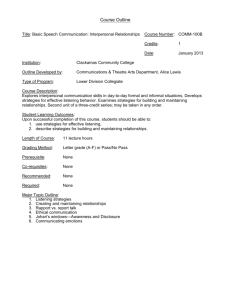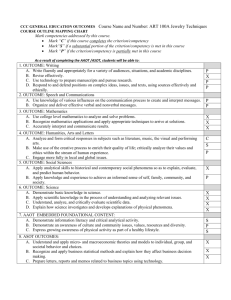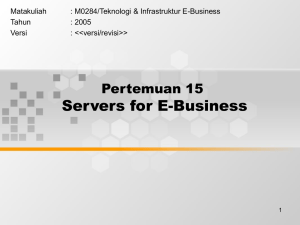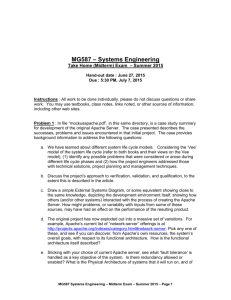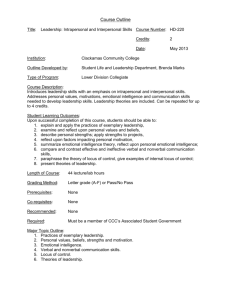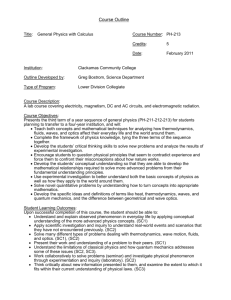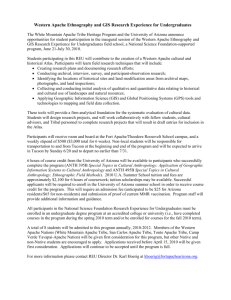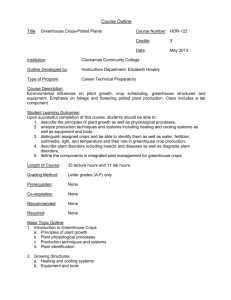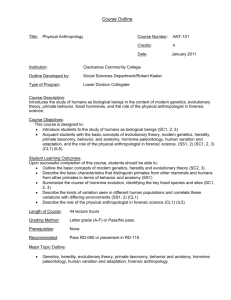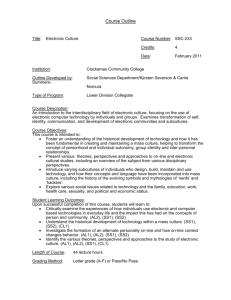Title: Web Server Administration
advertisement
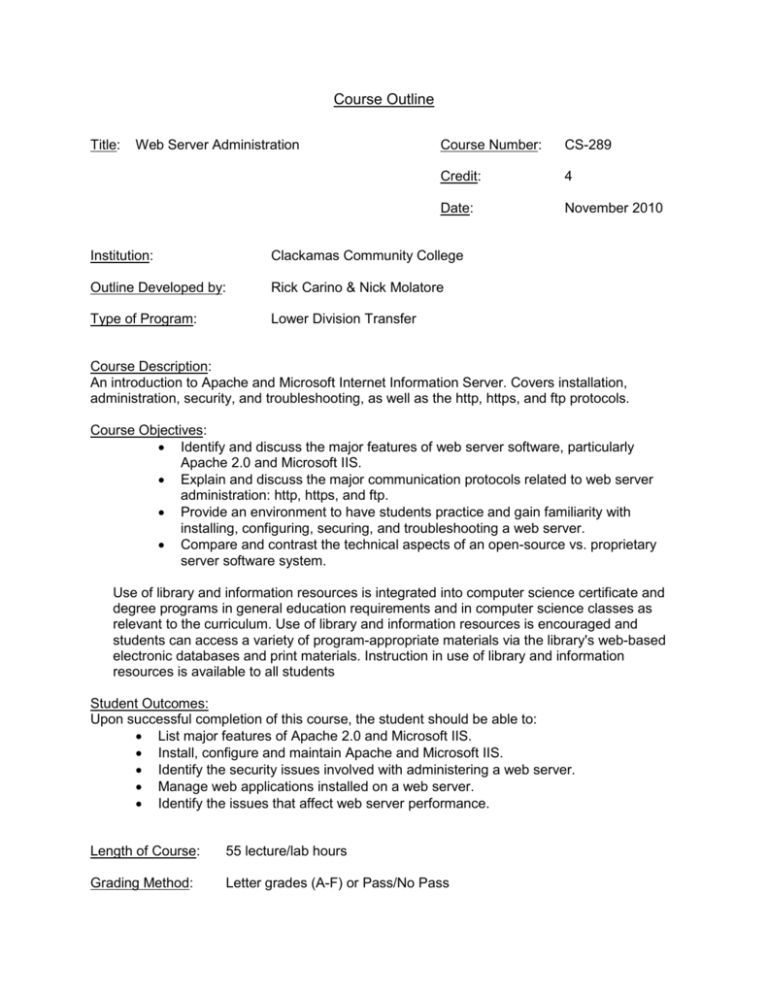
Course Outline Title: Web Server Administration Course Number: CS-289 Credit: 4 Date: November 2010 Institution: Clackamas Community College Outline Developed by: Rick Carino & Nick Molatore Type of Program: Lower Division Transfer Course Description: An introduction to Apache and Microsoft Internet Information Server. Covers installation, administration, security, and troubleshooting, as well as the http, https, and ftp protocols. Course Objectives: Identify and discuss the major features of web server software, particularly Apache 2.0 and Microsoft IIS. Explain and discuss the major communication protocols related to web server administration: http, https, and ftp. Provide an environment to have students practice and gain familiarity with installing, configuring, securing, and troubleshooting a web server. Compare and contrast the technical aspects of an open-source vs. proprietary server software system. Use of library and information resources is integrated into computer science certificate and degree programs in general education requirements and in computer science classes as relevant to the curriculum. Use of library and information resources is encouraged and students can access a variety of program-appropriate materials via the library's web-based electronic databases and print materials. Instruction in use of library and information resources is available to all students Student Outcomes: Upon successful completion of this course, the student should be able to: List major features of Apache 2.0 and Microsoft IIS. Install, configure and maintain Apache and Microsoft IIS. Identify the security issues involved with administering a web server. Manage web applications installed on a web server. Identify the issues that affect web server performance. Length of Course: 55 lecture/lab hours Grading Method: Letter grades (A-F) or Pass/No Pass Prerequisite: Pass CS-240L and CS-240W Major Topic Outline: I. Installation: A. Uninstall Apache/IIS B. Install in Custom Location C. Starting and stopping Apache D. Using Apache/IIS Documentation II. Tools for Administration: A. GUI tools B. Configuration files C. Configuration directives D. Directory structures E. Remote Administration F. Windows Scripting Host Programs III. Managing Virtual Hosts A. IP addressing B. Configuration file IV. Administering the WWW Service A. Master Properties B. Site Properties V. File types A. MIME B. Type Map files VI. URL mapping A. Apache B. Virtual Directories C. Virtual Servers VII. Content Negotiation VIII. Managing Active Content A. Filters and Handlers B. CGI C. Mod_Perl D. PHP IX. Security A. IP Address & Domain Name Restrictions B. Permissions (IIS, NTFS) C. Directory Browsing D. SSL E. Authentication F. File System Security G. Logging X. General Administration Tasks A. Clients B. Indexing C. FTP D. Performance E. SSL F. ASP/PHP Applications CCC AAOT/ASOT GENERAL EDUCATION OUTCOMES COURSE OUTLINE MAPPING CHART Course Title and Number: CS- 289 Web Server Administration Mark outcomes addressed by this course: Mark “C” if this course completely addresses the outcome. Students who successfully complete this course are likely to have attained this learning outcome. Mark “S” if this course substantially addresses the outcome. More than one course is required for the outcome to be completely addressed. Students who successfully complete all of the required courses are likely to have attained this learning outcome. Mark “P” if this course partially addresses the outcome. Students will have been exposed to the outcome as part of the class, but the class is not a primary means for attaining the outcome and assessment for general education purposes may not be necessary. As a result of completing the AAOT /ASOT general education requirements, students will be able to: WR: Writing Outcomes 1. Read actively, think critically, and write purposefully and capably for academic and, in some cases, professional audiences. 2. Locate, evaluate, and ethically utilize information to communicate effectively. 3. Demonstrate appropriate reasoning in response to complex issues. SP: Speech/Oral Communication Outcomes 1. Engage in ethical communication processes that accomplish goals. 2. Respond to the needs of diverse audiences and contexts. 3. Build and manage relationships. MA: Mathematics Outcomes 1. Use appropriate mathematics to solve problems. 2. Recognize which mathematical concepts are applicable to a scenario, apply appropriate mathematics and technology in its analysis, and then accurately interpret, validate, and communicate the results. AL: Arts and Letters Outcomes i 1. Interpret and engage in the Arts & Letters, making use of the creative process to enrich the quality of life. 2. Critically analyze values and ethics within a range of human experience and expression to engage more fully in local and global issues. SS: Social Science Outcomes 1. Apply analytical skills to social phenomena in order to understand human behavior. 2. Apply knowledge and experience to foster personal growth and better appreciate the diverse social world in which we live. SC: Science or Computer Science Outcomes 1. Gather, comprehend, and communicate scientific and technical information in order to explore ideas, models, and solutions and generate further questions. 2. Apply scientific and technical modes of inquiry, individually, and collaboratively, to critically evaluate existing or alternative explanations, solve problems, and make evidence-based decisions in an ethical manner. 3. Assess the strengths and weaknesses of scientific studies and critically examine the influence of scientific and technical knowledge on human society and the environment. CL: Cultural Literacy Outcome ii 1. Identify and analyze complex practices, values, and beliefs and the culturally and historically defined meanings of difference. IL: Information Literacy Outcomesiii 1. Formulate a problem statement. 2. Determine the nature and extent of the information needed to address the problem. 3. Access relevant information effectively and efficiently. 4. Evaluate information and its course critically. 5. Understand many of the economic, legal, and social issues surrounding the use of information. “Arts and Letters” refers to works of art, whether written, crafted, designed, or performed and documents of historical or cultural significance. ii Must be embedded in a course that meets the outcomes for Arts and Letters, Social Science, or Science/Computer Science. iii Must be embedded in the general education required Writing courses Revised 2010-2011 to reflect Statewide AAOT outcomes i P P P P P
